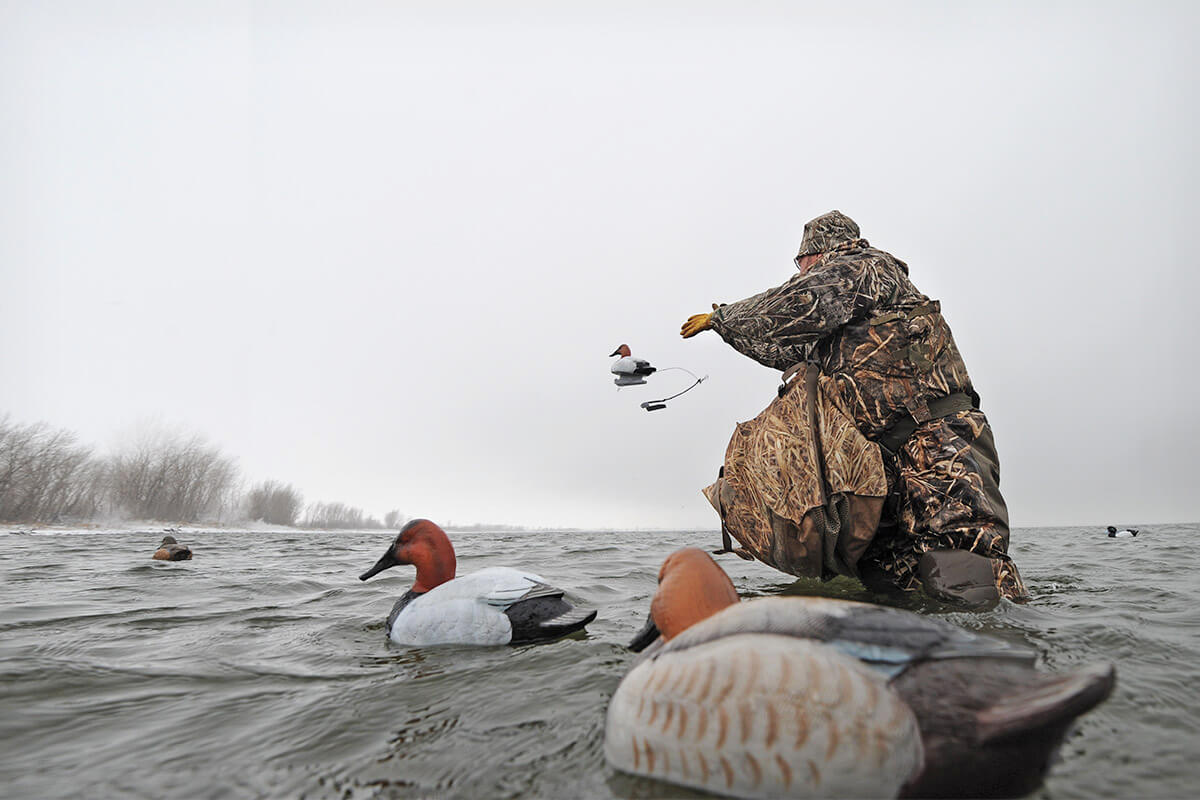
An ideal diver spread will match how the birds you’re hunting are flocked on the water. (Photo By: Jim Thompson)
Like the fly fisherman’s cardinal rule: Match the hatch. A spread of redheads makes sense along the Texas Gulf Coast, canvasback in Pool 9, or ring-necks in a small, wild rice pond. Match what you can, but chances are, you’re going to get a mix of divers coming through. The big three that most decoy makers build are bluebills, canvasbacks, and redheads —all will work in your spread.
If you go that route, though, your spread is going to consist of a lot of white, grey, and dabs of reds and black from the heads and chests. No question, white is effective on the water, but the rest really don’t provide much contrast—especially the greys (the near all-grey redhead and grey-shouldered bluebill will nearly blend into the water).
Be sure to check out The Complete Guide to Diver Duck Hunting Part 1
What to Expect
Anyone that has logged a hot minute of scouting will attest to seeing black dots on the water. Those that hunt dabblers know this all too well with mallard decoys. The grey drakes can blend in with the water while the hens can blend in a bit too much with vegetation. It’s why many add black ducks to their spreads —black is one of the best contrasts on the water. I’m balking traditions here, but if you’re starting to build a spread, the best overall decoy species to get are ring-necks. The reason is twofold. First, when it comes to contrast, nothing can compete with the drake’s black heads, chest, shoulders, and tail that perfectly surround a white-grey flank that flashes against grey waters. Secondly, they’re the only diver species consistently cracking in the top 10 of annual estimated duck harvest totals—the other 9 species are dabblers. This indicates they aren’t nearly as preferential as the other diver species to certain bodies of water: I’ve shot them in both small and massive waters and dang near everything in between. The same can be said with the nearly black coot.
Even if you don’t shoot coot, you’ll probably see plenty of them co-mingling with divers and also dabblers (there’s versatility in them). Building a spread prominently with black colored species is a great start, it but doesn’t have to end there. Many times, pochards raft on the water and even fly together, so you can sprinkle in any other diver species you’ve scouted for and what you’d like to shoot. Don’t be afraid to intermix – it’s a natural look in the wild.
Where I hunt, we shoot mostly ringers with an occasional bluebill, can, or redhead, with rafts of coots swimming amuck. That’s why I mix them randomly together on my decoy rafts and long lines as follows: 33% Ringnecks, 33% Coots, 17% Canvasback, 17% Redheads.
Bufflehead and goldeneye are a little different. Buffleheads are more apt to mix with other waterfowl and have no issues landing with nearly anything. Despite that, they are very strict on staying together both inflight and swimming. Their flocks are usually about a dozen or less, so put out a pod of 6-12 of them on the inside (their landing preference) of the kill hole. Goldeneyes are usually in similarly sized flocks too, but I have seen them amass in the hundreds in Alaska and Great Lakes. Where I hunt, flocks are usually no more than a dozen in flight, and they decoy on the outside of the spread and kill hole. They’re usually one of the last birds to migrate but some stragglers come down earlier with most of the other diver species. That’s why I deploy a pod of 6-12 on the outside of my spread during the diver migration. The last couple weeks of the season I have seen less divers but an uptick in goldeneyes. That’s when I start transitioning the spread from 8-12 dozen mixed divers down to 1-2 dozen goldeneye-only spreads.
Diver Duck Hunting Diver Decoys (Conventional/Non-conventional)
The old schoolers out there say that divers are so dumb that they’ll lock into a spread consisting of black milk jugs. I’m sure this is true, to a point. Empty milk jugs probably move on the water unlike any other decoy on the market – I think any duck, regardless of species, will lock into that type of motion (I’ve literally seen Canada geese and mallards swim to or land on my dog’s white bumper during offseason reps). They’re also relatively cheap once you drink the contents. Building a super spread of them may require a few years for those of you that are single. If you know any big families, though, chances are you could build a spread of black milk jugs in about a month.
Joking aside, a true unconventional decoy variance for the DIY type are v or y-boards. They may not ride well in choppy water but they’re relatively easy to deploy and some would argue put out more visibility than any conventional decoy.
Speaking of conventional, they come in quite an array. The classics are made of wood or cork and are a thing to behold. If you’re made of money to buy a spread like this or are a craftsman, go this route – there’s a certain romance about them like fly fishermen tying their own flies. The vast majority of us that don’t have deep pockets or are great carvers instead buy plastic or foam decoys. If you’re just starting out and want to build an inexpensive spread, there are plenty of old, plastic Flambeaus or Carry-Lites out there that people are pretty much giving away. Be warned that after one season, you’ll sink a dozen of them shooting at birds over the decoys and finishing them off on the water. Better to go with foam or foam-filled—aka “foamers.” On the cheap side, you can get classic Herter’s 63s or 72s from $5-8 a decoy – you’ll get a nod from all the old duck hunters at the launch if you go this route.
DON’T MISS the new HydroFoam diver duck floaters from Heyday Outdoor!
Those that want to dabble in painting their own decoys have a blank canvas to go with on the diver front. They’re a great intro into to painting blocks because drakes are adorned in black, white, and grey from head to tail while hens are various shades of browns and greys with a blotch or two of white. Dixie and Homer decoys are two great options if you want to go this route. Painting your own blocks are a great way to pass the offseason, and those of you that have kids might find this to be a fun project.
Foam-filled diver decoys tend to be heavier and may not move as easily on the water as standard, plastic decoys. No one in their right mind enjoys patching shot-up decoys with a hot glue gun after a hunt, which you may end up doing with plastic decoys, and 99% of the time they’re quickly forgotten in the hurry to pick up decoys and become useless weight in the decoy sack (they do make a great maraca).

Diver Duck Hunting Motion Decoys
Motion decoys are something nice to have in the decoy spread, especially on a calm day, but aren’t completely necessary. Employing your blind-mates to work jerk strings probably works but blind-mates aren’t always reliable to pull their string with each working group. Motion decoys do all the work for you, so you can focus on the hunt. Most spinning wing decoys mimic birds landing or stretching out their wings.
They’re usually affixed by a pole to the ground, but, if the water is too deep, there are some that float. Affix a ballast on the bottom of the floating types so you can use in rough waters without risking them tipping over. Having one or two spinners around the kill hole of the spread with a few single drop decoys in front of them is a good tactic to signify birds landing in your spread and thereby directing birds to land in the same spot. Adding some randomly in the spread and just above the surface adds more realism with birds stretching out their wings. It also helps divert the diver’s eyes to focus on the spread, as opposed to them being wary of the blind.
On calm days, it’s crucial to put motion on the water. Swimming decoys and pulsators/splashers (mallard butts that splash up water) add some much-needed movement.

Diver Duck Hunting Rigging Setups: Singles, Longlines, Rafts
Nothing is more synonymous with diver hunting than longlines. They serve as a runway to these swift flyers, providing massive visibility and essential control to their flight path (they have a knack for flying along them). The anatomy of a longline is basic: a longline anchored to the bottom with decoys affixed to the longline via drops. The longline consists of a ¼” sinking rope that can be 30 yards long (great for the heart of the spread) to 100 yards long (the primary/runway line) and anywhere in between. Decoys are affixed to the longline via drops: a thinner line that is either tied on or clipped on (via a trotline clip).
Drops can range from 1′-3′ long. I prefer drops tied directly to the line so there’s far less time wasted clipping and unclipping trotlines when setting out and picking up (time adds up exponentially when there are +12 dozen decoys to deal with) and the drop lengths be 3′ long. I’ve witnessed a handful of hunters that slept in too late rip around points with my long lines already deployed. The added drop length allows the longline to sink deeper in the water—preventing props from getting hung up or severing the long lines. Dogs are less prone to get wrapped up in them too.
The spacing between the drops can be 10′ (great for any lines that serve to build the core of the spread) to 10 yards (some go this distance when they deploy massive, 300-yard primary lines). At least the upwind end of the longline should be clipped to an anchor. Anchors can be down rigging balls, old window weights, 3-5-pound grapnel weights, etc. If hunting in current, you may need to use 8-20-pound boat anchors.

A modernized take on rigging is using decoy rafts. They’re the closest resemblance to a natural look of a raft of birds as possible. Decoys are clipped in a tight cluster of 12-18 decoys directly to a 5’x12′ sinking mesh mat that is clipped (via a carabiner) to a rope that is anchored to the bottom longline-sized anchor. I’ve put my 6 rafts through the wringer over the years and I’m not sure if a single stich from any of them is unhemmed. It doesn’t take more than 30 seconds to deploy or pick up, which means you can make quick work of 6 dozen decoys in just a few minutes. Another bonus is that dogs can climb right over the top of them when retrieving birds. I clip my long lines to the decoy rafts for even greater ease and customization.
Single decoys have their place in a diver spread, but only serve to break up the straight lines from the longlines and boxy rafts. Incorporating up to a dozen single decoys on their own weights is just the trick to create a more natural look. Make sure each are rigged to at least 20 feet of decoy line tied to a heavy decoy anchor weighing no less than 6 ounces.














